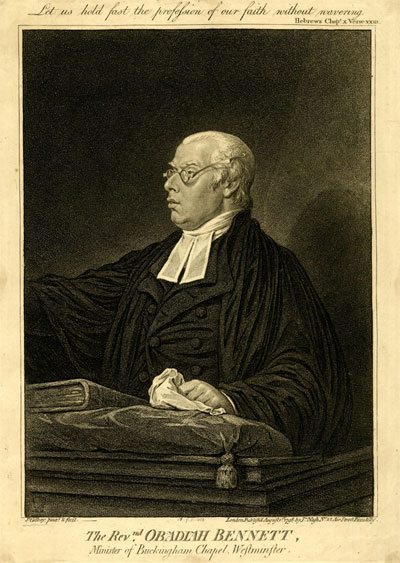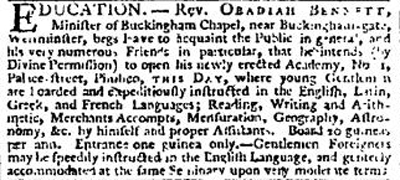The Rev.nd Obadiah Bennett,
Minister of Buckingham Chapel, Westminster
This is an unusual print in several ways. First of all, it is rare, appearing in the British Museum but in none of the other major Gillray collections.

Minister of Buckingham Chapel, Westminster
[August 1, 1798]
© Trustees of the British Museum
Second, it is an outstanding example of Gillray's abilities as a portraitist long after he is supposed to have given up atttempts to make himself known as a "serious" portrait artist. Further, it calls into question the often-heard remarks regarding his portraits of William Pitt that Gillray was incapable of taking a likeness without caricaturing the sitter. Here, there is no trace of satire or caricature. Bennett is shown dressed in a combination of academic and clerical robes preaching at a lectern, one hand gesturing to his audience the other grasping a handkerchief. Everything is beautifully rendered. The epigraph above the image from Hebrews and the title below the image are both in Gillray's most accomplished and professional scripts. And as the author line proclaims, the original image with its pose, attitude, and details was created by Gillray himself and then produced as a stipple etching.
Finally, the print is unusual in being (supposedly) published by J. Nash of Air Street, NOT by Hannah Humphrey with whom Gillray had a nearly exclusive publishing relationship by 1798. But since this is the only print in the British Museum with that publication line, I'm inclined to believe that it is one of Gillray's tongue-in-cheek fictions. After all, John Nash (not a printseller) was the principal architect of the buidings in and around Air Street.
All of this suggests that this print was a private commission, outside the usual political arena in which Gillray was now preeminent. So who was Obadiah Bennet? And how did he possess the clout (or cash) to obtain Gillray's services at such a time and for a print that would have required considerable effort and expense?
Since he is unlisted in the Clergy of the Church of England database (CCEd), Obadiah Bennett was most likely a dissenting Minister. If he was also a Moravian, that would explain the Gillray connection. Gillray's father was a long-time sexton in the Moravian Church in Chelsea. And around the time of this print, Gillray was in contact with the Moravian hierarchy on account of his father's failing health. Gillray might have accepted the commission as a gesture of thanks for the Moravians' care for his father.
But even if Bennett were not himself a Moravian, he might have had friends among the Moravians who could recommend Gillray to him and vice versa. Dissenting Ministers seem to have cooperated with one another in support of causes (such as the abolition of the slave trade) they viewed as worthy. In March of 1796, for instance, Bennett seems to have arranged for two other ministers to preach at his Buckingham Chapel "for the educating and cloathing [of] poor Children belonging to the Angel Chapel Society" as reported in the London Daily Advertiser (March 28). Three yerars later, Bennett's name, appears among 11 other Ministers and their chapels as the sponsors of Missionary Prayer-meetings for 1799 listed in the Missionary Magazine for March 17, 1799.
But the most extensive and revealing record of Obadiah Bennett appears in London Times for January 11 of 1796, where we find an advertisement (placed by Bennett himself) for a "newly erected Academy" in nearby Palace Street Pimlico, which would have been about a five-minute walk from his chapel near Buckingham Gate.

© London Times,
Like Gillray's print, the advertisement suggests a man both religious and academic. And we can infer that the print was designed to lend professional credibility to Bennett's efforts with his Academy. But the ad also suggests a man of perhaps unrealistic ambition. The extensive curriculum of classical and foreign languages, reading, writing, various forms of math, accounting, geography, and astronomy were to be taught by "himself and proper Assistants," none of whom are named.
From the few records I have found, Bennett's fortunes seem to have gone well enough. In 1802, four years after Gillray's print, Bennett still had sufficient reputation to be listed in an advertisement for Scott's Family Bible as one of the Ministers recommending the new edition.
But by the end of 1803, the minister Bennett disappears. The only Obadiah Bennett I can find is a "Taylor," recently added to the bankruptcy roles. And in 1804 the Buckingham Chapel is no longer listed in Buckingham Gate, but Pimlico, and the only Minister associated with it is E.A. Dunn. Did Bennett move his chapel to Pimlico when it could no longer be sustained in Buckingham Gate? Did he relinquish the Pimlico chapel to the Reverend Dunn? Is Obadiah Bennett, Taylor, the same man that tried to set up an Academy? Alas, I don't have answers to any of these questions, and would be grateful to hear from anyone who does.
Sources and Reading
- Commentary from the British Museum on The Rev.nd Obadiah Bennett, Minister of Buckingham Chapel, Westminster.
Comments & Corrections
NOTE: Comments and/or corrections are always appreciated. To make that easier, I have included a form below that you can use. I promise never to share any of the info provided without your express permission.